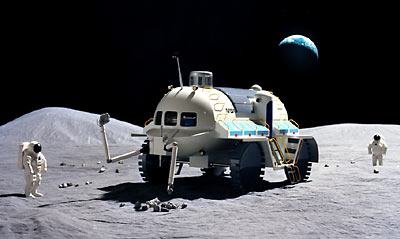Lunar rovers past and future<< page 1: concept becomes reality Missions accomplishedAt the Hadley region of the Moon, LRV-1 performed perfectly for Apollo 15 astronauts David Scott and Jim Irwin, and proved a safe and reliable vehicle for the lunar explorers. The rover extended the area of exploration from the lunar module from feet to miles, allowed more samples to be returned and even beamed live TV images back to Earth of the astronauts at work. The world was fascinated. Speaking from his office at Johnson Space Center in Houston, John Young, commander of Apollo 16, stated “What I was worried about driving the rover at Descartes was we would run across one of these block fields and take out the suspension system. We were very careful in going around all the blocks with the rover. Fortunately, it had Ackerman steering, so it could turn within its own length. It was very maneuverable. It did exactly what we wanted it to in terms of getting us around fast and to places we could never have gotten to walking.”
Eugene Cernan also extolled the virtues of the LRV. “The rover allowed us to explore the entire valley at Taurus-Littrow,” Cernan emphatically states, “from one end to the other, to climb hills we never could have been able to climb on foot, bringing back samples and pictures we wouldn’t have been able to get otherwise. The rover was just so versatile and gave us such an advantage within the timeframe that we had on the Moon. Without it, it would have cut down our science and geologic exploration by 70 percent. It was just a phenomenal asset.” Past as prologueThe Apollo LRVs were capable of much greater distances than were actually achieved, but the astronauts were limited in their traverses due to the available water and oxygen in their PLSS (Personal Life Support System) backpacks. In the event the LRV broke down, the astronauts would need enough air and water to hoof it back to the lunar lander. That was the impetus to look into larger pressurized lunar rovers with the capability of carrying much greater quantities of consumables for the astronauts of post-Apollo missions. As regular readers of The Space Review are aware, there were several initiatives during the 1980s and 1990s for a return to the Moon and eventually manned missions to Mars. (See “Aiming for Mars, grounded on Earth: part two”, February 23, 2004; and “The last lunar outpost”, March 15, 2004.) A pressurized vehicle for lunar exploration was seen as the next logical step. Numerous universities, several NASA centers as well as contractors to NASA such as Boeing produced papers on the design and operation of various pressurized lunar rovers. Among the schools presenting pressurized lunar rover concepts were Virginia Polytechnic Institute and State University, Florida Agricultural and Mechanical University, and Carnegie Mellon University. NASA centers including the Johnson Space Center, Langley Research Center, and NASA Headquarters also wrote their own proposals. Johnson Space Center produced a study in 1990 from its Lunar and Mars Exploration Office showing a pressurized lunar rover. (The office was later renamed the Planetary Projects Office). This office produced other proposals in the early 1990s, with some of the slickest design illustrations by the industrial design firm of John Frassanito and Associates in Houston. The large pressurized rovers were designed to take crews of four or more astronauts for extended lunar explorations. This is just the kind of vehicle John Young believes is necessary for future missions to the Moon. “Rovers will be the key to exploring large areas of the Moon like the south pole,” Young states emphatically. “The south pole of the Moon has the largest crater in the solar system at 2500 to 2800 kilometers across. When we go back to the Moon, we’ll have pressurized long-range rovers that can go for days and do much more exploring. We really don’t know much about the Moon. There are 14 million five hundred thousand square miles up there.”
Such pressurized rovers of necessity would have to be constructed on Earth. Due to their size and weight, they would require a super heavy lifter of the Saturn class of boosters. A cargo lander would then be required to take the rover from lunar orbit down to the surface of the Moon. The rover or rovers would operate as an extension of the lunar base already there. Realistically speaking, could all this be accomplished without prohibitive cost? There is a more likely scenario when astronauts return to the Moon. The original LRVs cost millions of dollars apiece in the early 1970s. One can only speculate what a much larger pressurized LRV would cost to build in the timeframe of this vision for space exploration. It is more likely the next generation LRV will borrow heavily from the original since it is a proven design, but the new LRV’s performance and range will reflect improvements in materials, battery-power, communications and positioning technology. Improvements in suits and PLSS will extend the time astronauts can spend on their EVAs. Pressurized rovers will eventually traverse Luna firma, but odds are the next LRV will bear a striking resemblance to the original. Home |
|
